
BIX ARTICLE
Sukuk Contracts in Malaysia
Mar 27, 2019
|
11 min read
Featured Posts
Social Bonds Illustrative Use-Of-Proceeds Case Studies Coronavirus
Jul 06, 2020
|
2 min read
Sustainable Banking Network (SBN) Creating Green Bond Markets
Jul 06, 2020
|
2 min read
Why is Inflation Making a Big Comeback After Being Absent for Decades in the U.S.?
Mar 24, 2022
|
7 min read
SC issues Corporate Governance Strategic Priorities 2021-2023
Mar 29, 2022
|
3 min read

The Accounting and Auditing Organisation for Islamic Financial Institutions (AAOIFI) which issues standards on accounting, auditing, governance, ethical, and Shari'a standards has laid down 14 different types of Sukuk. This article sets out 7 types which are mostly used in Malaysia sukuk market. The sukuk structures set out in this article rely on the creation of a Special Purpose Vehicle (SPV).
A special purpose vehicle or SPV will issue sukuk, which represent an undivided ownership interest in an underlying asset, transaction or project. Special purpose vehicle or SPV is a company that registered as a subsidiary with a legal status which allows it to secure its asset structure in such a manner in which the respective entity will not be affected in the situation in which the parent company enters into bankruptcy. In other words, SPV is a bridge that helps the parties involved in the contract to get their shares accordingly and to monitor their rights.
-
Sukuk Mudharabah (profit-sharing)
- It is a certificate that represent projects or activities that are managed on the basis of a mudharabah (partnership based on trust) contract. There will be one party/partner called the mudarib who will manage the project. Besides the mudarib, there is another partner called robbul-mal (owner of capital) who is the capital provider of the project and own shares in the mudarabah equity where his/her returns will follow the percentage of ownership share. The mobilised funds are the mudharabah capital.
In this transaction, the investors are the robbul-mar (capital owners) and the certificate holders of the assets of mudharabah.
The investors subscribe for sukuk and pay the proceeds to SPV. SPV declares a trust over the proceeds (and any assets or mudharabah interests acquired using the proceeds) and thereby acts as trustee on behalf of the investors. The profit from the investment activity is shared between both parties based on a pre-agreed ratio depending on how well the asset or project performs. They are also the capital providers and bear the losses if any except if it was due to negligence or mismanagement of the venture.
In a mudharabah sukuk, the sukuk holders are the silent partners, who don’t participate in the management of the underlying asset, business, or project. The working partner is the sukuk obligator or issuer. The sukuk obligator/issuer, as the working partner, is generally entitled to a fee and/or share of the profit, which is spelled out in the initial contract with investors.
However, mudharabah sukuk should not contain a guarantee from the issuer for the capital or a fixed profit, or a profit based on any percentage of the capital.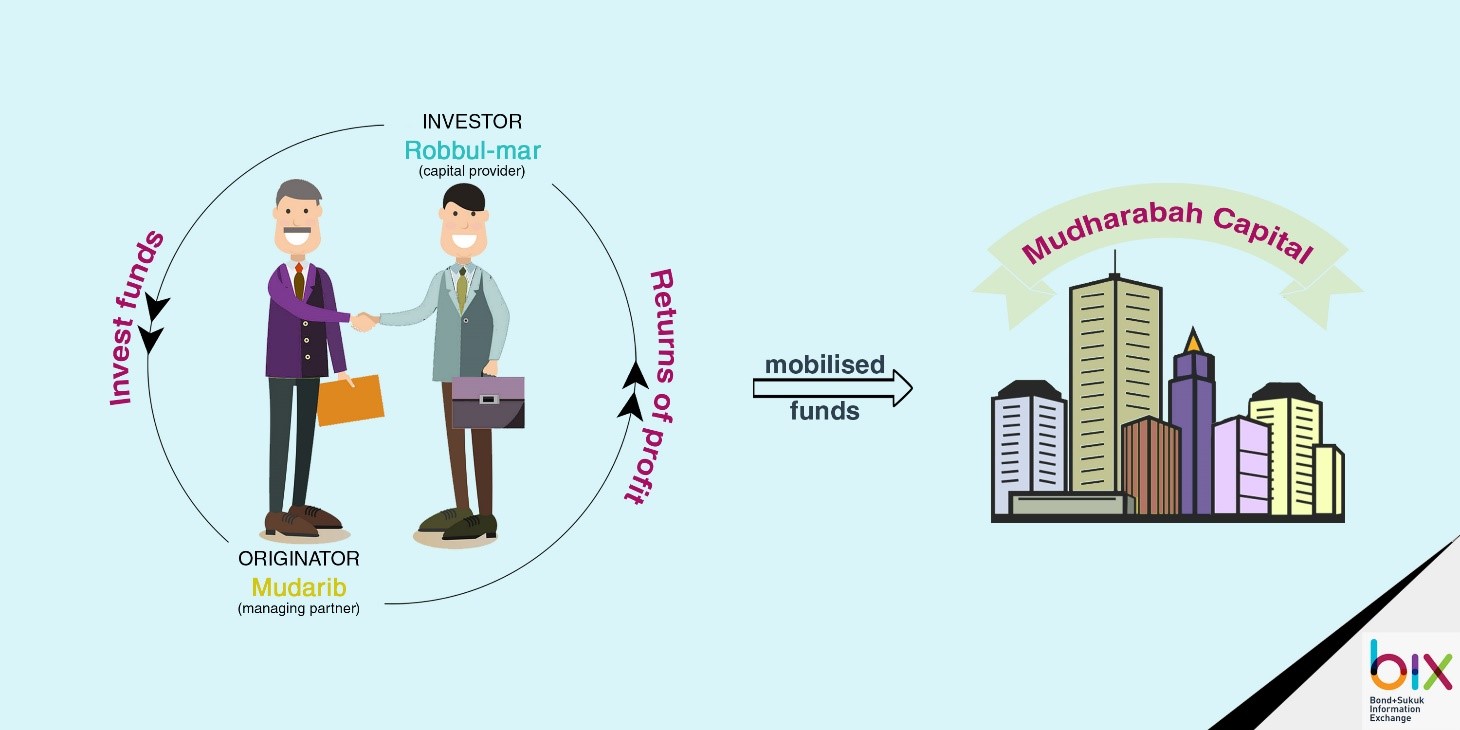
- It is a certificate that represent projects or activities that are managed on the basis of a mudharabah (partnership based on trust) contract. There will be one party/partner called the mudarib who will manage the project. Besides the mudarib, there is another partner called robbul-mal (owner of capital) who is the capital provider of the project and own shares in the mudarabah equity where his/her returns will follow the percentage of ownership share. The mobilised funds are the mudharabah capital.
-
Sukuk Musyarakah (profit and loss sharing)
- The term musyarakah is derived from the word shirkah, which means partnership. In its simplest form, a musyarakah arrangement is a partnership arrangement between two (or more) parties, where each partner makes a capital contribution to the partnership, in the form of either cash contributions or contributions in kind. The musyarakah partners share the profits of the musyarakah in pre-agreed proportions and share the losses of the musyarakah in proportion to their initial capital investment.
It does not differ from the mudharabah sukuk except in the organization of the relationship between the party issuing such sukuk and holders of these sukuk, whereby the party issuing sukuk forms a committee from the holders of the Sukuk who can be referred to for investment decisions.
Musyarakah sukuk are ideal for borrowing to finance large commercial ventures, such as a factory expansion or construction projects. A special purpose vehicle company (SPV) can purchase, commission or construct musyarakah assets owned, or to be bought or constructed by the issuing entity. The SPV pays cash towards the capital of the musyarakah and then leases the underlying musyarakah assets to the issuing entity, for a period equal to the maturity of the Sukuk, at agreed regular fixed or floating rentals. Upon default or maturity, the issuing entity issues a promise to musyarakah units from the SPV at an agreed price. Musyarakah sukuk can be treated as negotiable instruments and can be bought and sold in the secondary market.
Losses of the musyarakah must be shared by the partners in proportion to their capital contributions to the musyarakah. The ratio of profit sharing must be agreed at the outset and, unlike losses, does not have to be in proportion to each partner’s capital contribution.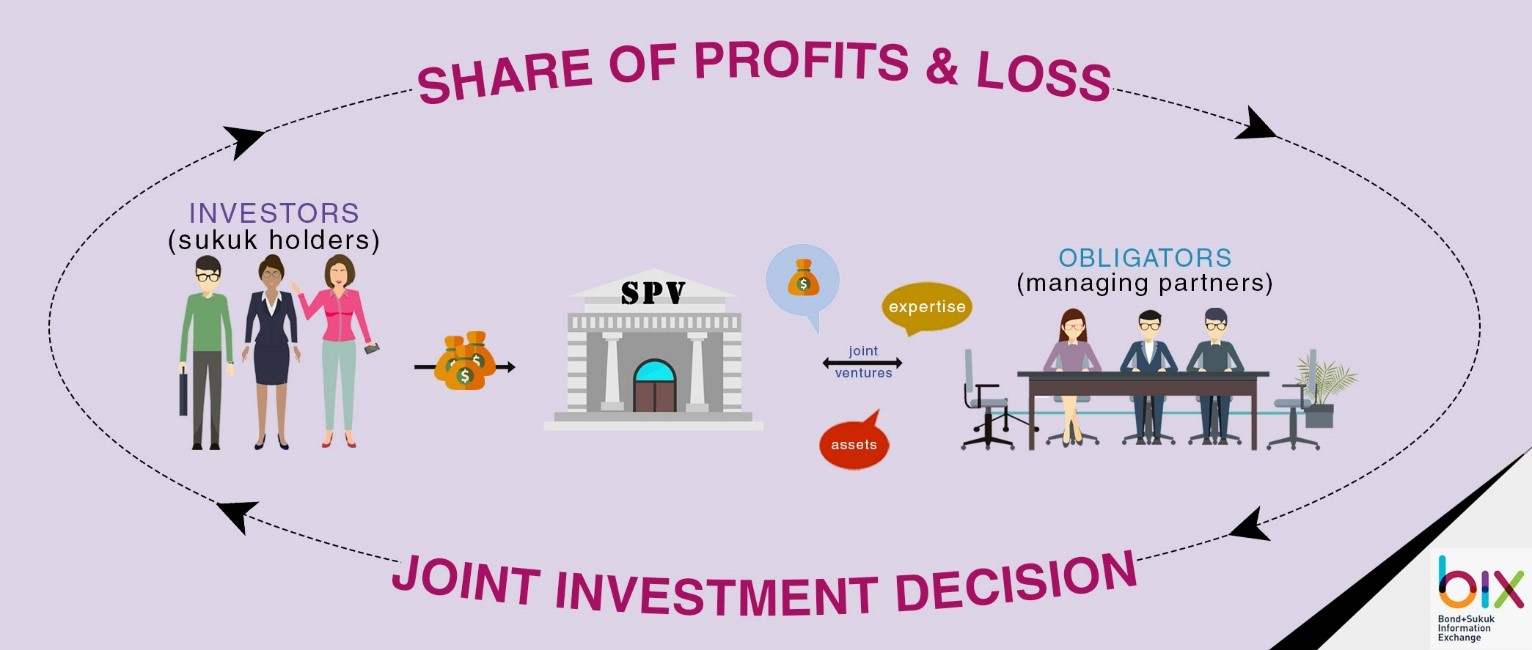
- The term musyarakah is derived from the word shirkah, which means partnership. In its simplest form, a musyarakah arrangement is a partnership arrangement between two (or more) parties, where each partner makes a capital contribution to the partnership, in the form of either cash contributions or contributions in kind. The musyarakah partners share the profits of the musyarakah in pre-agreed proportions and share the losses of the musyarakah in proportion to their initial capital investment.
-
Sukuk Murabahah (cost-plus sale/deferred payment)
- In the Islamic finance industry, the term murabahah is broadly understood to refer to a contractual arrangement between an investor (the seller) and an originator (the purchaser) whereby the investor would sell specified assets or commodities to the originator for spot delivery in the expectation that the customer would be able to meet its deferred payment obligations under the murabahah agreement.
The deferred price would typically include the cost-plus-profit-margin basis at which the investor had purchased the assets or commodities, plus a pre-agreed mark-up representing the profit generated from its involvement in the transaction. The payments of the deferred price from the originator may be structured as periodical payments on dates specified at the outset. This setup is a fixed-income type of sukuk, and the SPV facilitates the transaction between the sukuk holders and the obligator.
Murabahah sukuk cannot be legally traded at the secondary market, as the certificates represent a debt owing from the subsequent buyer of the commodity to the Sukuk holders and such trading in debt on a deferred basis is not permitted by Shariah.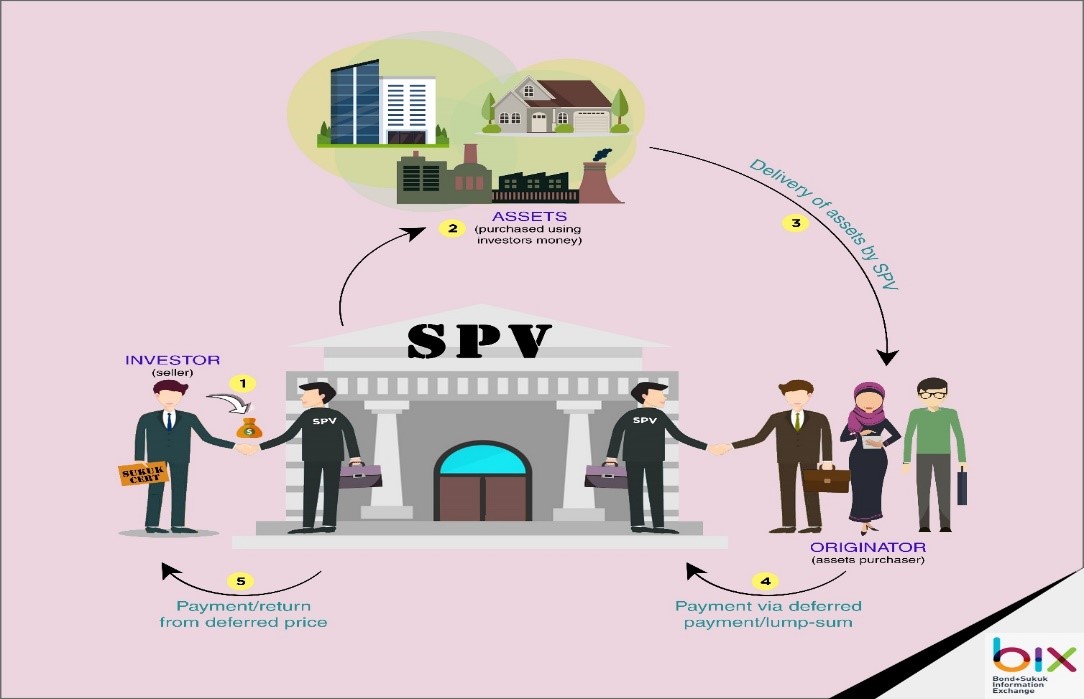
- In the Islamic finance industry, the term murabahah is broadly understood to refer to a contractual arrangement between an investor (the seller) and an originator (the purchaser) whereby the investor would sell specified assets or commodities to the originator for spot delivery in the expectation that the customer would be able to meet its deferred payment obligations under the murabahah agreement.
-
Sukuk Al-Wakalah (Agent)
- Al-Wakalah structure stems from the concept of a wakala which means ‘an arrangement whereby one party entrusts another party to act on its behalf’. In general, it is a contract in which a party authorises another party (usually an agent or wakeel) to act on behalf of the former based on the agreed terms and conditions as long as he or she is alive. Here, a wakeel could be appointed to manage the wakalah portfolio with the aim to generate an agreed-upon profit return.
An investor appoints an agent (wakeel) through SPV to invest funds provided by the investor into a pool of investments or assets and the wakeel lends his/her expertise and manages those investments on behalf of the principal for a particular duration to generate an agreed upon profit return. The SPV and wakeel enter into a wakalah agreement, which will govern the appointment, scope of services and fees payable to the wakeel, if any.
The wakalah structure comprises a pool or portfolio of assets or investments as opposed to a particular tangible asset or assets. This will leave the investors with choices of investment portfolios. The wakeel thereby uses its expertise to select and manage investments on behalf of the investor to ensure that the portfolio will generate the expected profit rate agreed by the principal.
The profit is divided between the parties according to certain ratios, an investor via a wakalah structure will only receive the profit return agreed between the parties at the outset. Any profit in excess of the agreed-upon profit return will be kept by the wakeel as a performance or an incentive fee. The wakeel is not held to be a partner in the arrangement and therefore, does not need to share the risk of loss in the agreement.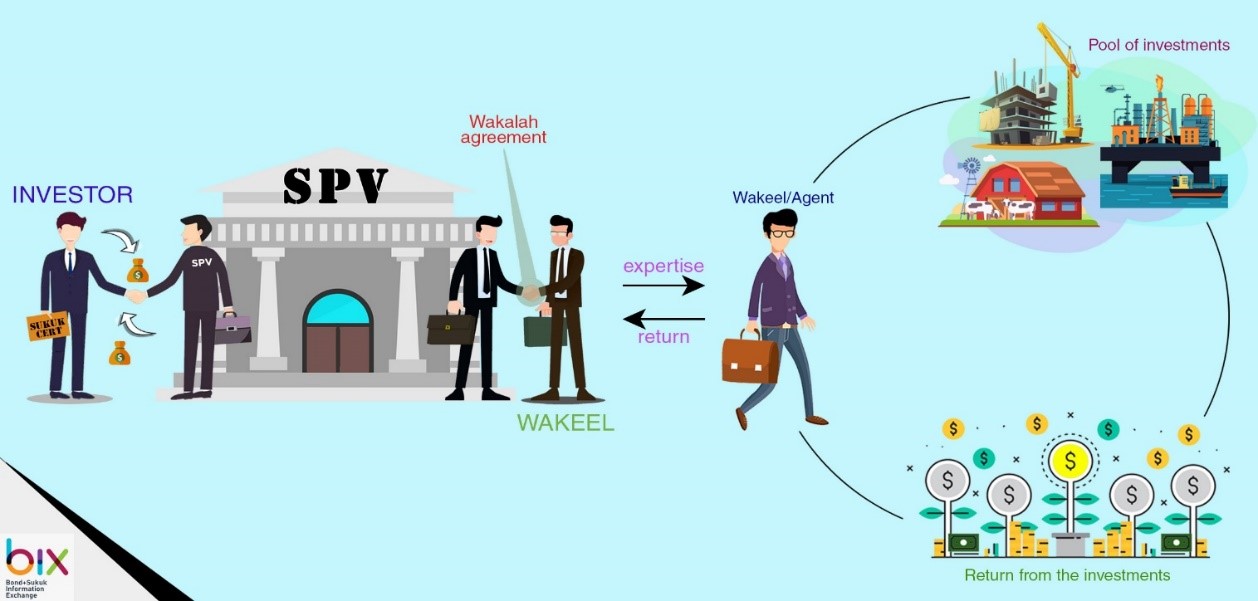
- Al-Wakalah structure stems from the concept of a wakala which means ‘an arrangement whereby one party entrusts another party to act on its behalf’. In general, it is a contract in which a party authorises another party (usually an agent or wakeel) to act on behalf of the former based on the agreed terms and conditions as long as he or she is alive. Here, a wakeel could be appointed to manage the wakalah portfolio with the aim to generate an agreed-upon profit return.
-
Sukuk Ijarah (leasing)
- In the Islamic finance industry, the term ijarah is broadly understood to mean the ‘transfer of the *usufruct of an asset to another person in exchange for a rent claimed from him’ or, more literally, a “lease”.
*(the legal right to use someone else's property temporarily and to keep any profit made from it)
The basic idea of ijarah is that the investors (sukuk holders) are the capital providers of the asset and are entitled to receive a return when that asset is leased. In this scenario, the SPV (lessor) receives the sukuk proceeds from the investors; in return, each investor gets a portion of ownership in the asset to be leased. The SPV buys the asset from a seller. SPV then lease it back under an ijarah contract. The company that use the asset and pays rental fee to the SPV is called the lessee.
However, the ownership of the asset itself is not transferred and will always remain with the SPV (lessor).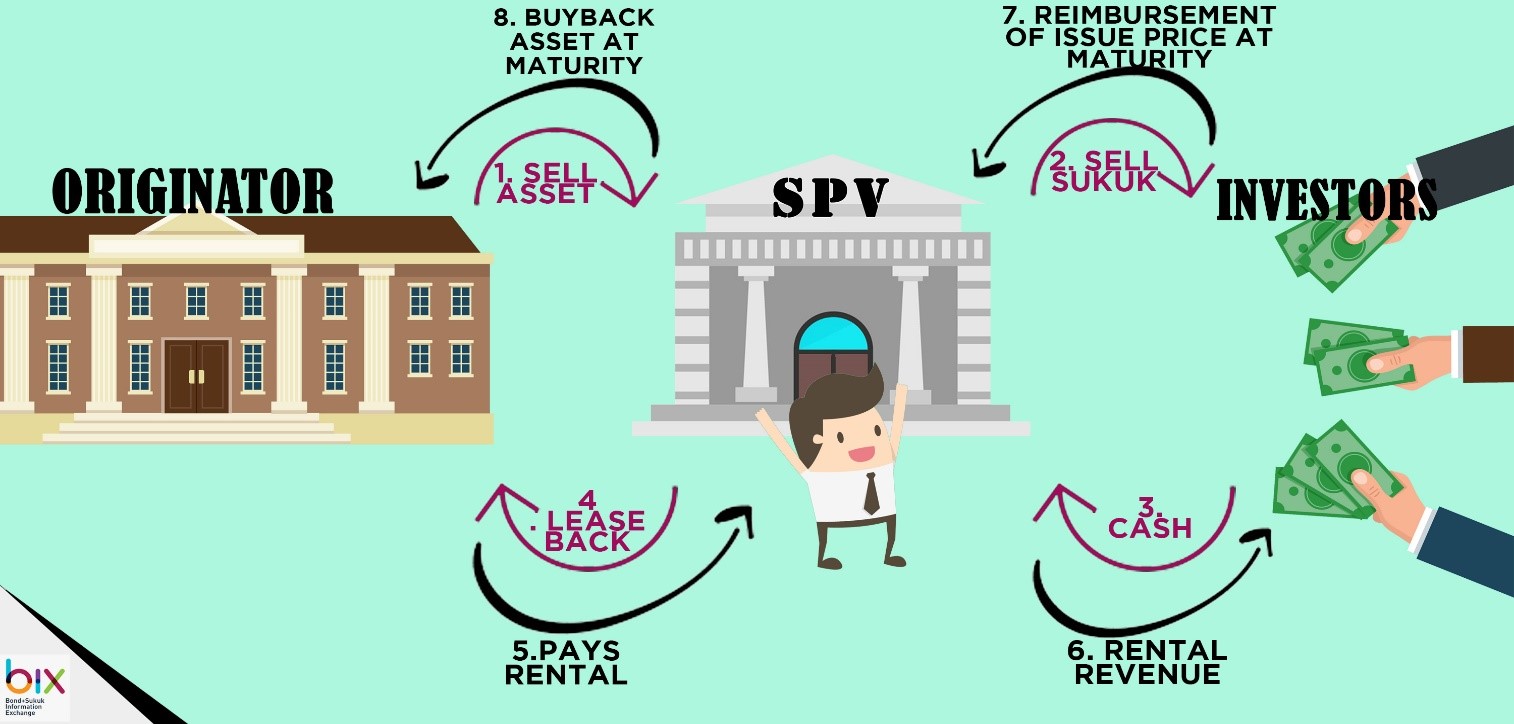 Generally, in order for a sale to be valid under Shari’a the object forming the subject matter of the sale must be in existence and in the physical or constructive possession of the seller. The exceptions to this general position are sales effected pursuant to salam and istisna contracts
Generally, in order for a sale to be valid under Shari’a the object forming the subject matter of the sale must be in existence and in the physical or constructive possession of the seller. The exceptions to this general position are sales effected pursuant to salam and istisna contracts
- In the Islamic finance industry, the term ijarah is broadly understood to mean the ‘transfer of the *usufruct of an asset to another person in exchange for a rent claimed from him’ or, more literally, a “lease”.
-
Sukuk Salam (deferred delivery purchase)
- In its simplest form, a salam contract involves the purchase of assets by one party from another party on immediate payment and deferred delivery terms. The purchase price of the assets is typically referred to as the salam capital and is paid at the time of entering into the salam contract. A salam contract may be construed as being synonymous with the objective of a forward sale contract. Forward sale contracts are generally forbidden under Shari’a unless the element of uncertainty (gharar) inherent in such contracts is effectively eradicated. For this reason, certain criteria must be met in order for a salam contract to be Shari’a compliant.
In salam sukuk, the sukuk holders’ (investors’) funds are used to purchase assets from an obligator (seller) in the future. Investors pay in an advance funds to the SPV in return for a promise to deliver a return at a future date. The SPV provides the money to the obligator (seller). This contract requires an agent (which may be a separate underwriter) who will sell the future assets because the investors want money in return for their investment — not the assets themselves. The proceeds from the sale (typically the cost of the assets plus a profit) are returned to the sukuk holders. Salam sukuk are used to support a company’s short-term liquidity requirements.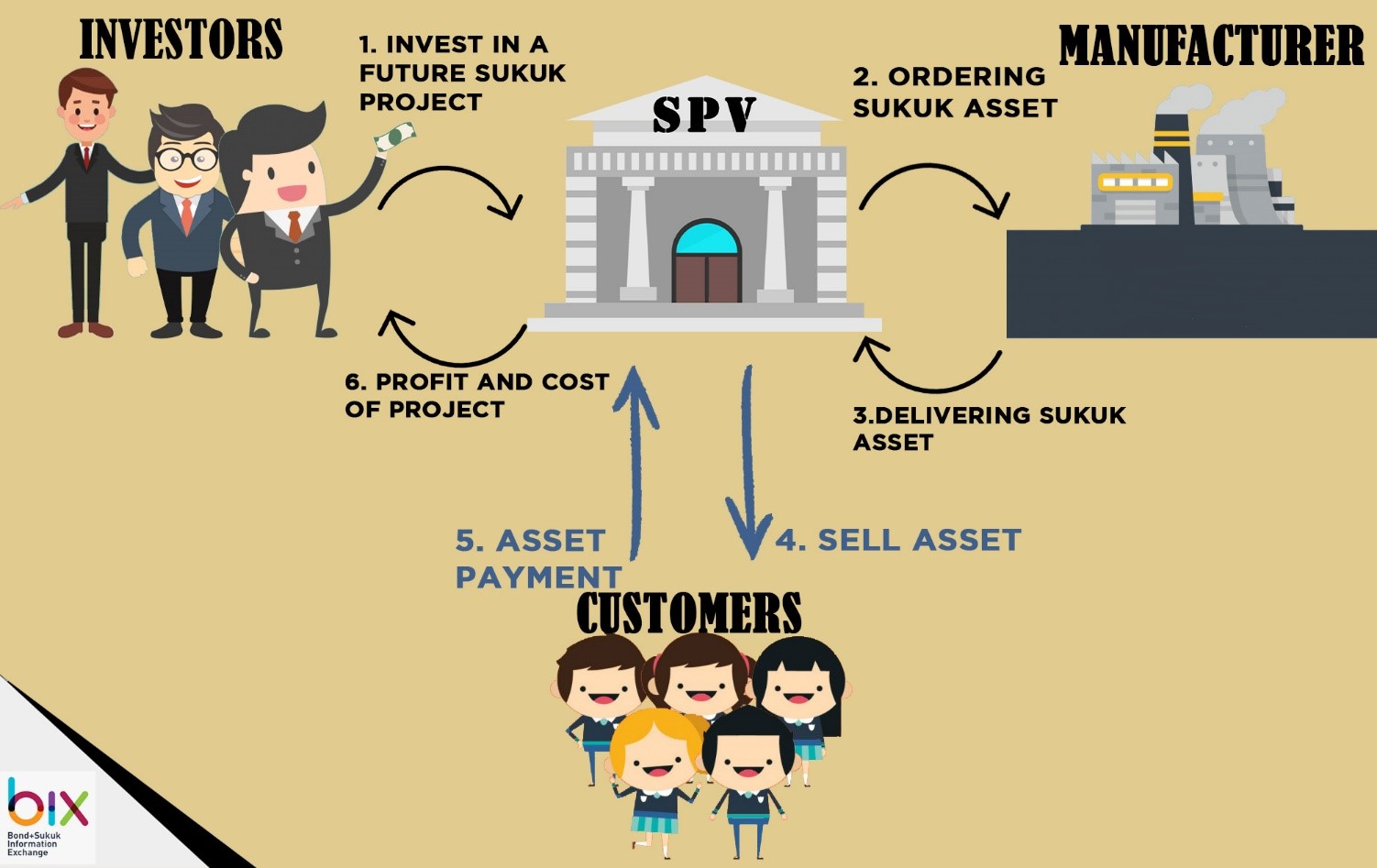 Although the use of salam has been, and is, utilised by some institutions for short-term liquidity purposes, its use as the platform for issuing sukuk, as an alternative to conventional bonds, is rare in comparison to some of the more prevalent structures like sukuk ijarah.
Although the use of salam has been, and is, utilised by some institutions for short-term liquidity purposes, its use as the platform for issuing sukuk, as an alternative to conventional bonds, is rare in comparison to some of the more prevalent structures like sukuk ijarah.
- In its simplest form, a salam contract involves the purchase of assets by one party from another party on immediate payment and deferred delivery terms. The purchase price of the assets is typically referred to as the salam capital and is paid at the time of entering into the salam contract. A salam contract may be construed as being synonymous with the objective of a forward sale contract. Forward sale contracts are generally forbidden under Shari’a unless the element of uncertainty (gharar) inherent in such contracts is effectively eradicated. For this reason, certain criteria must be met in order for a salam contract to be Shari’a compliant.
-
Sukuk Istisna’ (Islamic project bond)
- Istisna’ is a contractual agreement for manufacturing goods and commodities, allowing cash payment in advance and future delivery or a future payment and future delivery. A manufacturer or builder agrees to produce or build a well described good or building at a given price on a given date in the future. Price can be paid in instalments, step by step as agreed between the parties. Istisna’ can be used for providing the facility of financing the manufacture or construction of houses, plants, projects, and building of bridges, roads and highways.
Istisna’ sukuk are based on this type of contract. The investors (sukuk holders) are the buyers of the project, and the obligator is the manufacturer. The obligator (manufacturer) agrees to manufacture the project in the future and deliver it to the buyer through SPV, who (based on a separate ijarah contract) will lease the asset to another party (lessee) for regular payments or sell the asset to another buyer. The process of issuing istisna’ sukuk begins when the obligator (manufacturer or contractor) and the SPV sign an istisna’ contract.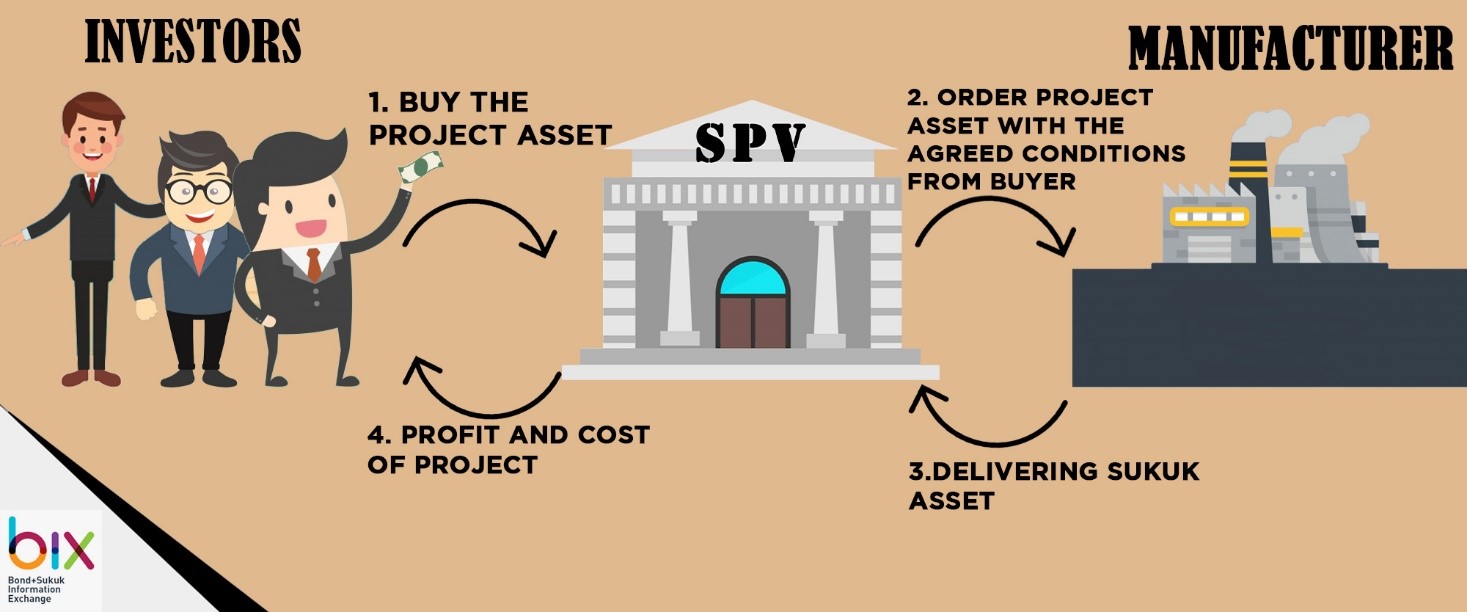 Sukuk istisna’ are certificates that carry equal value and are issued with the aim of mobilising the funds required for producing products that are owned by the certificate holders and are quite useful for financing large infrastructure projects. Shari’a prohibition of riba precludes the sale of these debt certificates to a third party at any price other than their face value. Clearly such certificates, which may be cashed only on maturity, cannot have a secondary market.
Sukuk istisna’ are certificates that carry equal value and are issued with the aim of mobilising the funds required for producing products that are owned by the certificate holders and are quite useful for financing large infrastructure projects. Shari’a prohibition of riba precludes the sale of these debt certificates to a third party at any price other than their face value. Clearly such certificates, which may be cashed only on maturity, cannot have a secondary market.
- Istisna’ is a contractual agreement for manufacturing goods and commodities, allowing cash payment in advance and future delivery or a future payment and future delivery. A manufacturer or builder agrees to produce or build a well described good or building at a given price on a given date in the future. Price can be paid in instalments, step by step as agreed between the parties. Istisna’ can be used for providing the facility of financing the manufacture or construction of houses, plants, projects, and building of bridges, roads and highways.
- Click the BIX SEARCH function on the front page
- Filter the function to SUKUK
- Select preferred sukuk
- Under BOND+SUKUK INFORMATION, look at the ISLAMIC CONCEPT section
Disclaimer
This report has been prepared and issued by Bond and Sukuk Information Platform Sdn Bhd (“the Company”). The information provided in this report is of a general nature and has been prepared for information purposes only. It is not intended to constitute research or as advice for any investor. The information in this report is not and should not be construed or considered as an offer, recommendation or solicitation for investments. Investors are advised to make their own independent evaluation of the information contained in this report, consider their own individual investment objectives, financial situation and particular needs and should seek appropriate personalised financial advice from a qualified professional to suit individual circumstances and risk profile.
The information contained in this report is prepared from data believed to be correct and reliable at the time of issuance of this report. While every effort is made to ensure the information is up-to-date and correct, the Company does not make any guarantee, representation or warranty, express or implied, as to the adequacy, accuracy, completeness, reliability or fairness of any such information contained in this report and accordingly, neither the Company nor any of its affiliates nor its related persons shall not be liable in any manner whatsoever for any consequences (including but not limited to any direct, indirect or consequential losses, loss of profits and damages) of any reliance thereon or usage thereof.
YOU MAY ALSO LIKE
ARTICLE
Dec 01, 2025
|
4 min read
ARTICLE
Nov 04, 2025
|
4 min read
ARTICLE
Oct 16, 2025
|
5 min read
ARTICLE
Sep 03, 2025
|
4 min read


